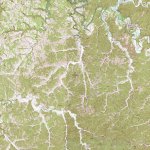KY Hiker
Bronze Member
- Oct 28, 2014
- 1,539
- 3,221
- Detector(s) used
- Whites
- Primary Interest:
- All Treasure Hunting
Dry being a relative term? I assume it ran between the Licking and Red watersheds ?
Follow along with the video below to see how to install our site as a web app on your home screen.
Note: This feature may not be available in some browsers.
I'm not trying to interject myself into this "argument", I really don't care about the Swift legend at all but while you guys are trying to pin down this "great ridge"...perhaps throw this into the mix for debate.
The Mount Sterling to Pound Gap Road aka The State Road. Official work began in 1817 so one would think that it was a trail or trace way before that. It's pretty much modern day US 460. The area beginning in Frenchburg and going east were called "The Dry Ridge" during that time. I have a vague map that shows that the Dry Ridge was a rather large piece of real estate.
 Many times the name was derived from land features or a distinguishing land mark back in the day. That is one piece of road I don't remember ever driving. It is a great big piece of ground Frenchburg to W Liberty
Many times the name was derived from land features or a distinguishing land mark back in the day. That is one piece of road I don't remember ever driving. It is a great big piece of ground Frenchburg to W LibertyI haven't found any passages or place name data that give "The Dry Ridge" it's name. I can say with certainty that the name comes up frequently during the Civil War era.

 Old Field lay just north of the area of Dry ridge don't it ?
Old Field lay just north of the area of Dry ridge don't it ?Would be any ones guess. Maybe reverse deceptionOld Field lay just north of the area of Dry ridge don't it ?
I was under the impression Old Indian Fields was between W. Liberty and Ezel Or the general area.